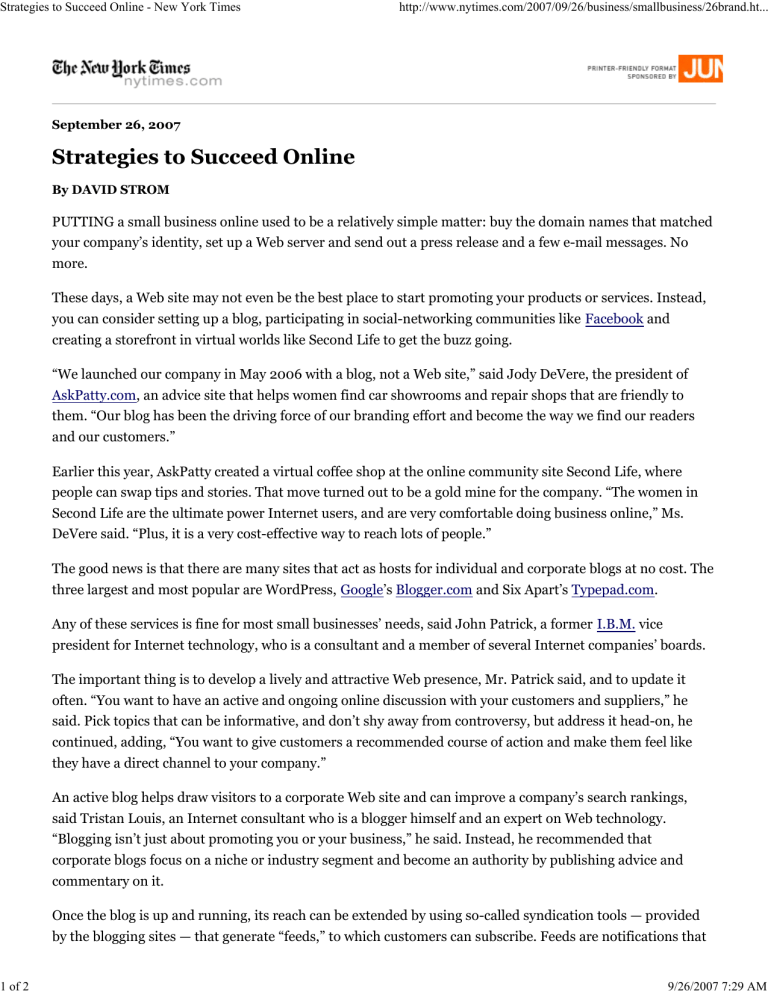Strategies to Succeed Online - New York Times

Strategies to Succeed Online - New York Times http://www.nytimes.com/2007/09/26/business/smallbusiness/26brand.ht...
1 of 2
September 26, 2007
Strategies to Succeed Online
By DAVID STROM
PUTTING a small business online used to be a relatively simple matter: buy the domain names that matched your company’s identity, set up a Web server and send out a press release and a few e-mail messages. No more.
These days, a Web site may not even be the best place to start promoting your products or services. Instead, you can consider setting up a blog, participating in social-networking communities like Facebook and creating a storefront in virtual worlds like Second Life to get the buzz going.
“We launched our company in May 2006 with a blog, not a Web site,” said Jody DeVere, the president of
AskPatty.com
, an advice site that helps women find car showrooms and repair shops that are friendly to them. “Our blog has been the driving force of our branding effort and become the way we find our readers and our customers.”
Earlier this year, AskPatty created a virtual coffee shop at the online community site Second Life, where people can swap tips and stories. That move turned out to be a gold mine for the company. “The women in
Second Life are the ultimate power Internet users, and are very comfortable doing business online,” Ms.
DeVere said. “Plus, it is a very cost-effective way to reach lots of people.”
The good news is that there are many sites that act as hosts for individual and corporate blogs at no cost. The three largest and most popular are WordPress, Google ’s Blogger.com
and Six Apart’s Typepad.com
.
Any of these services is fine for most small businesses’ needs, said John Patrick, a former I.B.M.
vice president for Internet technology, who is a consultant and a member of several Internet companies’ boards.
The important thing is to develop a lively and attractive Web presence, Mr. Patrick said, and to update it often. “You want to have an active and ongoing online discussion with your customers and suppliers,” he said. Pick topics that can be informative, and don’t shy away from controversy, but address it head-on, he continued, adding, “You want to give customers a recommended course of action and make them feel like they have a direct channel to your company.”
An active blog helps draw visitors to a corporate Web site and can improve a company’s search rankings, said Tristan Louis, an Internet consultant who is a blogger himself and an expert on Web technology.
“Blogging isn’t just about promoting you or your business,” he said. Instead, he recommended that corporate blogs focus on a niche or industry segment and become an authority by publishing advice and commentary on it.
Once the blog is up and running, its reach can be extended by using so-called syndication tools — provided by the blogging sites — that generate “feeds,” to which customers can subscribe. Feeds are notifications that
9/26/2007 7:29 AM
Strategies to Succeed Online - New York Times http://www.nytimes.com/2007/09/26/business/smallbusiness/26brand.ht...
tell you when new content has been added, like comments and posts. Given the work involved, many businesses now have staff members whose responsibilities include maintaining Internet activities like blogs and online storefronts.
“The old ways of hiring a public relations firm and putting out press releases just don’t cut it anymore,” Mr.
Patrick said. “Today’s businesses have to be more hands-on, grass roots, interactive and maintain this flow of continuous communications.”
Besides having a person responsible for online communities and communications, businesses must strive to develop a more conversational approach that includes everyone from the chief executive to the mailroom clerk. More than merely participating in social networks like Facebook and MySpace , that means answering e-mail, too.
In addition, corporations should make use of e-mail distribution lists (also called Listservs or groups) to stay in touch regularly with their customers, employees and suppliers. Running such lists used to require software that was sophisticated, expensive and quirky. Now there are popular services sponsored by Yahoo
( groups.yahoo.com
), Microsoft ( groups.msn.com
) and Google ( google.com/groups ) that offer free distribution-list programs.
What a company should not be doing is spending lots of money on dot-com speculators, buying specialized software or even paying for the services of Web developers.
As Ms. DeVere said: “A new business doesn’t have the money to build a brand and pay for advertising. The biggest investment is your time, and these tools require a lot of that, but they can really pay off.”
Copyright 2007 The New York Times Company
Privacy Policy Search Corrections RSS First Look Help Contact Us Work for Us Site Map
2 of 2 9/26/2007 7:29 AM











